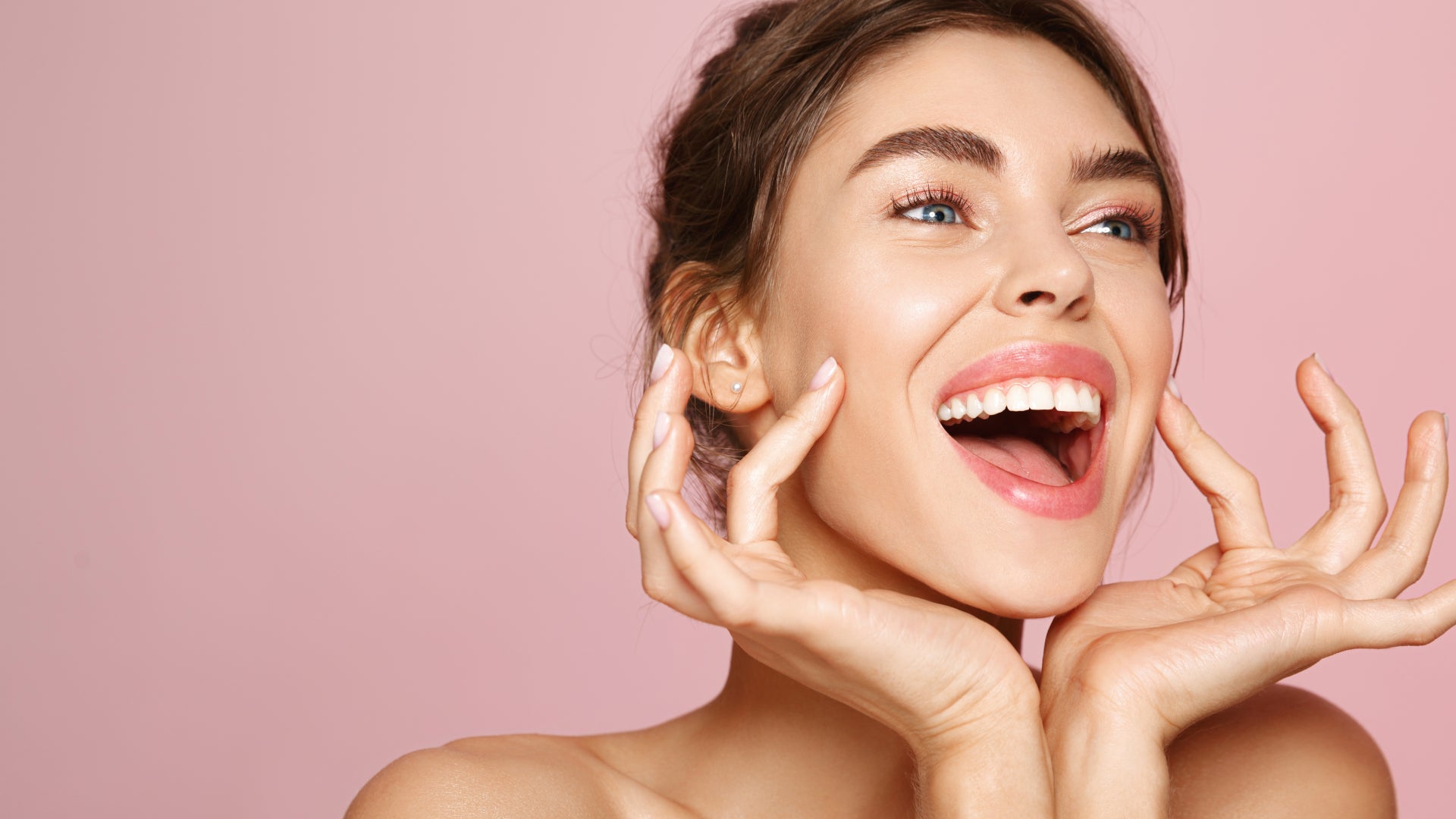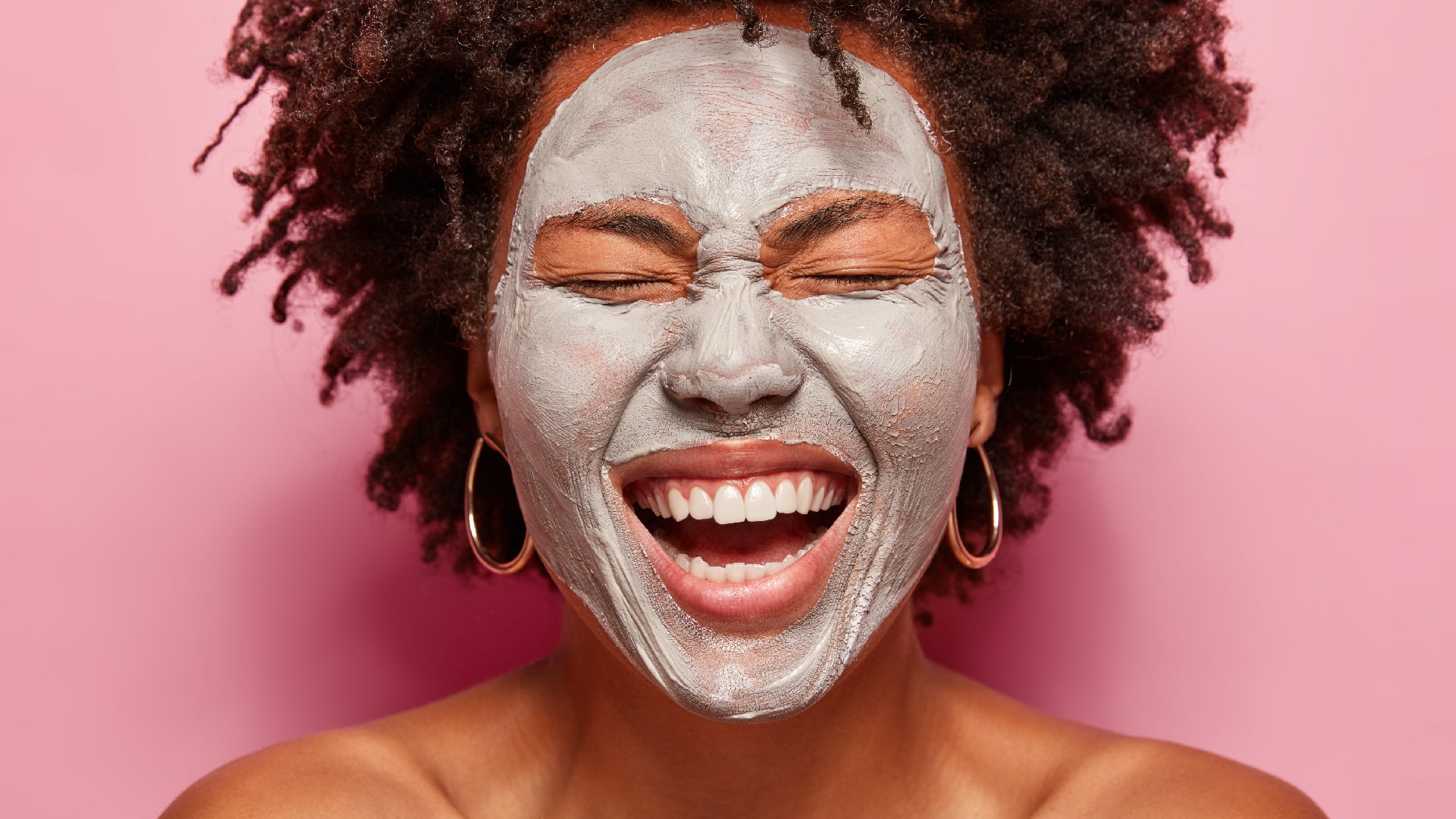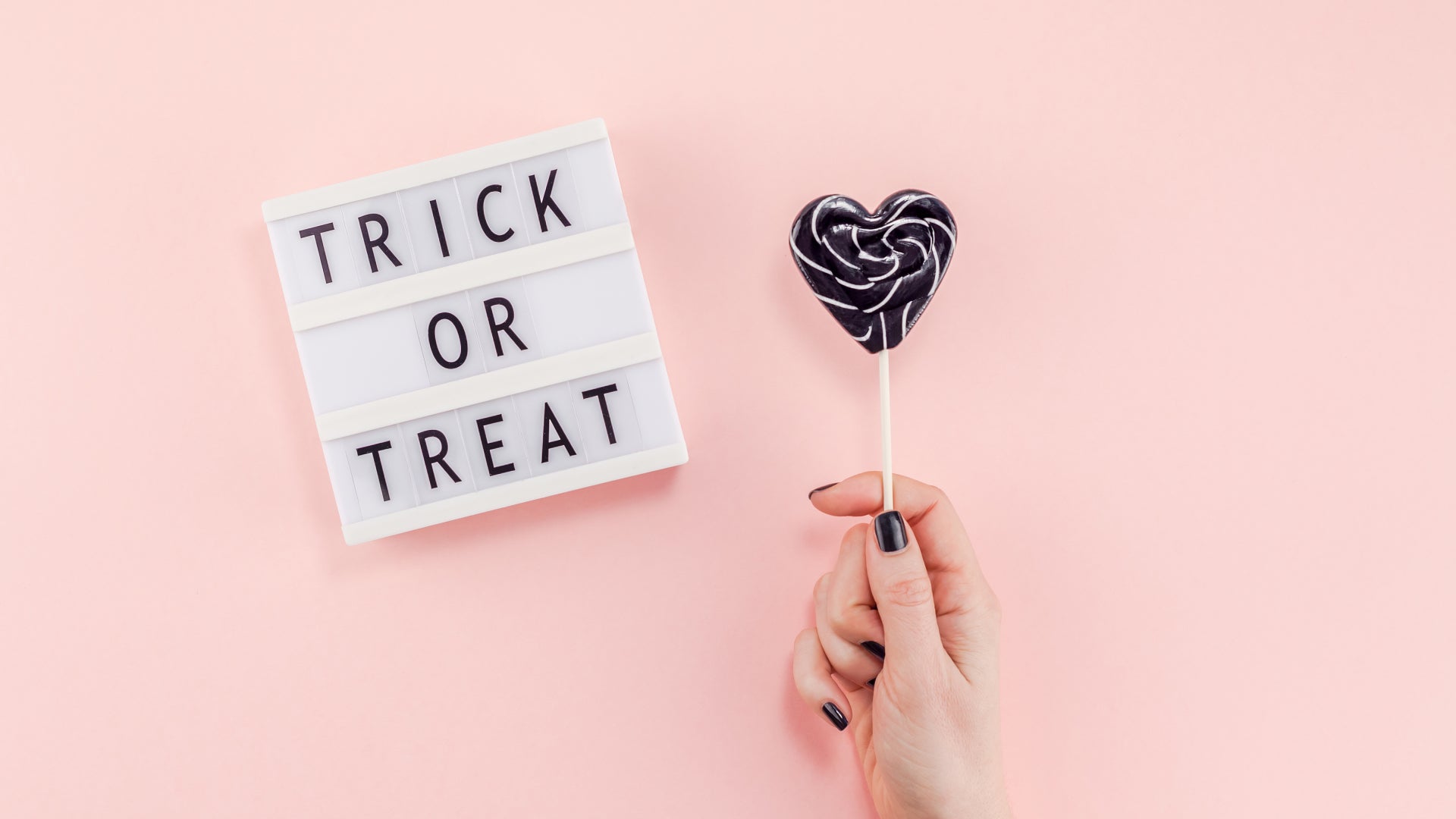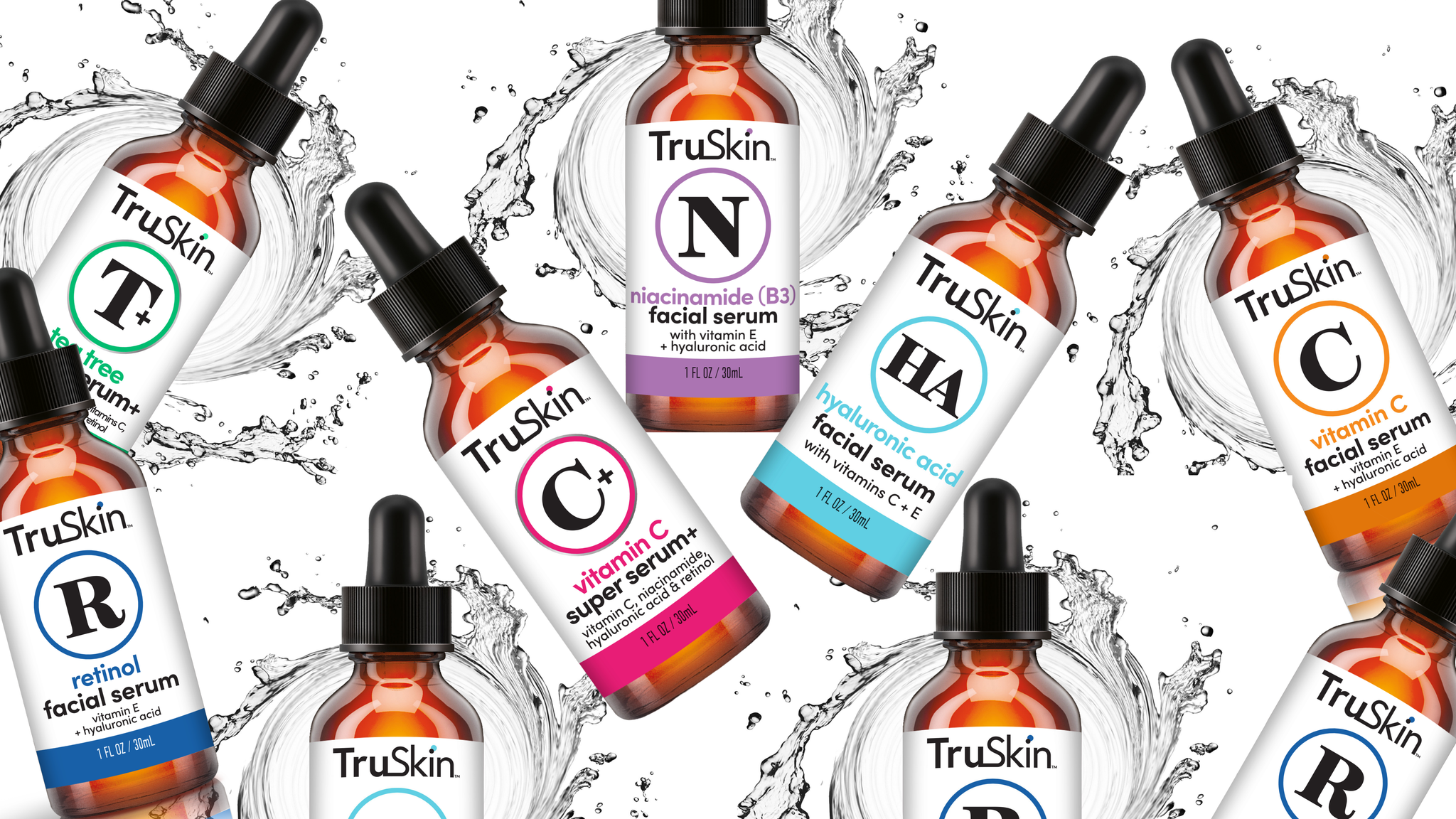
True Radical Honesty From Our Community
What To Do If You Hate Those Fine Lines Around Your Lips
Read MoreAdvice for all of your skin care needs
- all articles
- Acne
- Anti-Aging
- Collagen
- Combination Skin
- Company Announcements
- dry skin
- Exfoliation
- Eye Care
- Facial Redness
- Grooming
- Holidays
- Hyaluronic Acid
- Niacinamide
- Oily Skin
- Retinol
- Sensitive Skin
- Skincare
- Skincare Guide
- Skincare Ingredients
- Skincare Routine
- Skincare Tips
- Sun Protection
- Toner
- Vegan Skincare
- Vitamin C
- view all
- Acne
- Anti-Aging
- Collagen
- Combination Skin
- Company Announcements
- dry skin
- Exfoliation
- Eye Care
- Facial Redness
- Grooming
- Holidays
- Hyaluronic Acid
- Niacinamide
- Oily Skin
- Retinol
- Sensitive Skin
- Skincare
- Skincare Guide
- Skincare Ingredients
- Skincare Routine
- Skincare Tips
- Sun Protection
- Toner
- Vegan Skincare
- Vitamin C
-
Not that we’re dissing retinol. It’s just that it’s not the ONLY skincare ingredient out there worth a place in your daily regime…
Don’t get us wrong, retinol gives us all the feels and we’re mad about its cunning ability to improve everything from wrinkles and dark spots to acne and sagging skin. But it’s pretty potent stuff, so not everyone’s skin can get away with using it on the reg. Also, it’s not the be-all and end-all. In fact there are plenty of other trusted skincare ingredients that offer awesome anti-aging benefits for no-so-youthful-looking skin.
Of course, any brand promising you miracles like a ‘face lift in a bottle’ is lying to you – no matter what kind of clinically-proven wonder-potions are packed inside. But if you keep at it, and give skincare time to work, certain ingredients are guaranteed to offer real, skin-changing results.
Here are our top five…
1. Exfoliating Acids
According to the Mayo Clinic, exfoliating acids like AHAs (alpha hydroxy acids), BHAs (beta hydroxy acids) and PHAs (poly hydroxy acids) are among the most effective ingredients for reducing the visible signs of aging. Unlike manual exfoliators like scrubs, loofahs and face cloths that require some kind of physical movement to work, exfoliating acids dissolve the bonds between dead skin cells to encourage them to get a move on and fall away from the surface of your skin. This process accelerates cellular turnover and works to brighten, smooth and even out your entire complexion. It also helps prepare your skin to better absorb and reap the benefits of the rest of your skincare routine.
You’ll find exfoliating acids in various forms across anything from cleansers to serums, the most common of which are glycolic, lactic, gluconic and salicylic acids. We formulate salicylic acid into our Vitamin C Super Serum+ which is a great choice for aging skin. Always patch test first, then apply it to clean, dry skin before moisturizing.
2. Niacinamide
A form of vitamin B3, niacinamide is a very effective antioxidant that’s been gaining popularity as a skincare ingredient in recent years. And it’s about time, too.
Not a blog post goes by in which we don’t talk about antioxidants, yet here we go again –sorry, not sorry. Antioxidants are up there as some of the most important things to include in your skincare regime. Granted, cleanser, moisturizer and sunscreen are THE most important products for maintaining healthy skin, but if you care about defying lines, wrinkles and so on, antioxidants are everything. How so? Because they protect your skin from free radicals which are unstable oxygen molecules that wreak havoc on your skin when it’s exposed to things like UV radiation and environmental pollution.
Niacinamide is very well tolerated by the skin which makes it a great choice for sensitive skin. Research also shows that it increases the production of ceramides in the top layers of your skin which improves your barrier function, increases moisturization and helps reduce the appearance of fine lines and wrinkles. It also reduces inflammation, diminishes discoloration, fights breakouts and balances sebum. Is there anything niacinamide can’t do? For sure, but who needs a facial serum to walk the dog?
Try our awesome Niacinamide Facial Serum which blends this potent but skin-friendly antioxidant with healing vitamin E and hydrating hyaluronic acid.
3. MSM
Often overshadowed by the big guns, MSM is 100 percent worth a place in your skincare routine. And here’s why. Otherwise known as methylsulfonylmethane (agreed, a real mouthful), MSM is a sulfur compound which primarily contains sulfur, as well as small amounts of carbon, hydrogen and oxygen. Sulfur is extremely plentiful in the human body and found mainly in your skin and bones. It’s often known as the ‘healing mineral’ due to its ability to support healthy collagen synthesis, boost circulation, reduce inflammation and detoxify. Impressive stuff, right?
As a topical ingredient, MSM has been proven to not only increase collagen production, but to also reduce environmental damage by increasing your levels of glutathione. Glutathione is one of your body’s most important, naturally-occurring antioxidants, helping to fight oxidative stress caused by those devils called free radicals. We hate free radicals. You should hate free radicals, too.
You’ll find MSM in a bunch of your favorite TruSkin products including our Hyaluronic Eye Cream.
4. Peptides
Peptides can be tricky to get your head around, but simply put they’re chemical compounds made up of amino acids. Now, if you paid attention in 7th grade biology you’ll remember that amino acids combine to form proteins and are pretty much the building blocks of the human body, aiding in important functions like growth and repair. Well, while proteins are made up of long chains of amino acids, peptides are the little guys, made up of shorter chains.
In skincare, certain peptides act like little messengers to encourage your cells to produce more proteins – namely collagen, elastin and keratin – and simultaneously improve your skin’s texture and tone. They can work on fine lines, wrinkles, dark spots, even breakouts. But only if you choose the right ones…
One of the most effective peptides to look out for is Matrixyl 3000 which is thought to be able to almost double the amount of collagen your cells produce. Impressed? Much? Then you have to try our Peptide Eye Gel and Ocean Minerals Super Toner which both contain the mighty Matrixyl 3000 as well as plenty of other skin-loving and anti-aging ingredients.
5. Vitamin C
Another, dare we say it, powerful antioxidant, vitamin C is so good, we like to tout its abilities on an almost weekly basis! But it’s so much more than a free radical-fighting powerhouse. It’s literally ‘the’ ingredient for boosting radiance and diminishing dark spots.
So, how does that work? Well, studies have shown that it reduces the amount of melanin your skin produces by inhibiting tyrosinase (a catalyst for melanin production). By hampering melanin, vitamin C works hard to fade existing dark spots, help stop new ones from forming and give you a more glowy complexion. Oh, vitamin C also promotes cellular turnover and collagen production as a couple of extra bonuses.
Topical vitamin C takes on many forms, most commonly l-ascorbic acid and sodium ascorbyl phosphate (SAP). L-ascorbic acid is the pure form but it’s notoriously unstable meaning it breaks down easily, therefore becoming less effective. It can also be a little potent for sensitive skin so, instead, we use SAP across all of our C-products because it’s way gentler on the skin, still super effective and maintains its stability for much longer. SAP is the salt version of pure vitamin C which is why our infamous Vitamin C Facial Serum looks a little cloudy.
So, now you know!
Why Retinol Isn’t The Only Answer To Aging Skin
read more -
Feel like you might be overloading and stressing out your skin? Then the best ways to get results from your skincare is to go low and slow. Say hello to skincare microdosing...
Many skincare fads come and go and oftentimes they’re not worth the time of day (here’s looking at you ‘slugging’). But every now and again, something crops up that actually does your skin the world of good.
One such thing is microdosing. To be honest, skincare microdosing isn’t a new phenomenon, but something we’ve advocated forever – it’s simply been given a name. So, what does it mean? Simple: it’s the process of using lower concentrations of active ingredients in your routine, so as not to irritate your skin with potent skin-changers like retinol, vitamin C and exfoliating acids like glycolic and salicylic. These kind of active ingredients are extremely effective on the skin, but they can be a little too effective and intimidating for some folks, causing no end of problems like unwanted redness, dryness or irritation.
Even if you don’t have sensitive skin, your skin can only take so much before it will start freaking out and reacting to this bombardment of ingredients. Take exfoliating acids, for example. Use these in high strengths every day and you skin’s natural renewal system simply won’t be able to keep up, risking flaking, peeling, redness and dryness. Continue on this ‘no pain, no gain’ road and you could even risk longer-term damage such as dermatitis and sun damage.
Applying such ingredients in smaller doses, however, is a much better way to treat your skin with respect. It’s all about paring back your regime to avoid overloading your skin with a complicated cocktail of powerful ingredients and products. This gives your skin time to accept and better tolerate these potent, active ingredients, allowing you to safely use retinol and friends more regularly while avoiding damage to your skin’s all-important barrier function.
Your skin’s barrier is the absolute foundation to a healthy complexion. This is the very top layer (the stratum corneum) which works hard to defend your skin from environmental toxins and damage, while simultaneously retaining water to keep it soft, supple and well moisturized. If you upset your barrier with a super harsh skincare routine, beware because it will thank you with dryness, redness, breakouts, itching, inflammation, sensitivities and no end of other problems. So, you gotta treat it with respect. This means gentle cleansing, no hot water, exfoliating with care and never overloading it with too many active ingredients, lotions and potions – aka microdosing.
The 3 Rules Of Skincare Microdosing
Is your skin feeling overwhelmed by an over-zealous daily routine right now? Then here’s how to cut back and nail this microdosing malarkey…
1. Refine Your Skincare Regime
Microdosing traditionally takes on the form of using low rather than high concentrations of active ingredients. This means you don’t need to waste time hunting down the latest, super potent anti-aging serum that promises a massive hit of 5 percent retinol. Instead, look for products that contain smaller amounts (even 0.1 percent of retinol can offer great benefits).
A great trick here is to try a moisturizer instead of a serum. Moisturizers usually contain less active ingredients and don’t penetrate your skin as deeply as serums, meaning they’re kinder to sensitive skin. Try our Retinol Moisturizer for a gentle hit of retinol with much less chances of causing irritation.
You could also think about swapping out some potent ingredients for their gentler alternatives. Pure vitamin C, for example, is known as l-ascorbic acid and, while this provides awesome brightening and antioxidant protection for your skin, l-ascorbic acid is extremely powerful and can irritate some skin types. Instead, we use a vitamin C derivative called sodium ascorbyl phosphate in our Vitamin C Facial Serum and, in fact, across all of our C products. Sodium ascorbyl phosphate is way kinder to your skin and much safer to use daily as long as your skin can tolerate it. Not sure it can? Then carry out a patch test first. In fact, even if you think your skin will be OK, it’s always prudent to patch test, just in case.
Other ways to successfully microdose? Pare down your routine to just the essentials you know are good for your skin. The three absolute musts are cleanser, moisturizer and sunscreen, then you can add in one or two treatments, an eye cream and you should be golden.
Finally, always use your products as directed and never apply too much – this is literally the opposite of what microdosing is trying to achieve! For help on how much product you need, check out our handy guide, right here.
2. Be Patient
Of course, there has to be a trade-off from using lower concentrations of active ingredients rather than going for the heavy-hitters. And this is, it will take a little longer for your products to show visible results.
But come on now, if you’re noticing some skin sensitivities, waiting a few extra weeks (around six to eight is probably the sweet spot) will be so worth it in the long-run. And hey, if your skin adapts to ingredients pretty swiftly, you can always up your dosage accordingly. It’s all about listening to your skin.
3. NEVER Microdose SPF
If there’s one product you should never scrimp on, it’s sunscreen. Too much of a good thing simply does not apply here. According to the American Academy of Dermatology (AAD) you should apply a sun protection with at least SPF 30 to your face every morning to block a good 97 percent of the sun’s UVB rays. You must also look for broad-spectrum formulations that offer UVA as well as UVB protection. UVA rays are the ones that age you up (think A for aging), while UVB rays are responsible for burning (B for burning). And they can both lead to skin cancer, so it’s vital to protect your skin from the works.
Apply your sunscreen generously (again, no microdosing, please) and don’t give up in winter. The sun can damage your skin just a much when the weather’s lousy as when the sun is at its best. End of discussion.
Skincare Microdosing: What’s That All About?
read more -
Because now is the best time to plan for party-ready skin. Panicking the night before a big event? Asking for trouble…
We know it’s only November, but Thanksgiving is imminent and December is officially party time. And to be honest, last-minute skincare miracles are all well and good, but when you go into panic mode and overload your skin with lasers, peels, scrubs and potent skincare all at once your skin will repay you not by looking glowing and gorgeous, but with the exact opposite – redness, rawness, inflammation and irritation. Now, we don’t like to be presumptuous, but we don’t reckon any of those are high on your party skin wish list. Are we right or are we right?
So, if your skin is feeling a bit drab right now, a long-term party prep regime is exactly what you need to set your skin up for success. And don’t worry, you don’t need to spend hours preening your face every morning and every night. Just a few extra minutes here and there will make the world of difference. Then when those invites start pouring in, you will be 100 percent ready.
Now, let’s get started, shall we? The countdown is on…
Party Skin Prep Tip #1: Get Your Daily Fix Of Vitamin C
You might have noticed we’re major fans of vitamin C. Our whole brand was born from our Vitamin C Facial Serum and since its launch in 2013 it’s grown to be America’s highest-rated serum with over 50,000 five-star reviews on Amazon (and counting!). Not that we like to brag, but… OK, we do, just a little bit.
One of the most important ingredients for strong, radiant, healthy skin, vitamin C is an absolute must in the run up to the party season. Not on board yet? Then now’s the time to start reaping its countless benefits (which you can read about right here). Do a patch test first (so important!), then apply your serum to dry, clean skin before moisturizing for the best results. This is so all those active ingredients can get straight into your skin, exactly where it’s needed, rather than sitting on top of your moisturizer, fighting to get through.
We recommend applying our Vitamin C Facial Serum every day for the best results. If you’re new to vitamin C, however, and have sensitive skin, start by using it just two or three times a week to ensure your skin has time to get used to it. Then you can build up to daily, maybe even twice daily if your skin can tolerate it.
Party Skin Prep Tip #2: Drink Plenty Of Water
Let’s get one thing straight, there’s very little research to prove that drinking oceans of water directly hydrates your skin. Yes, dehydrated skin lacks water, but there’s no proof that what you drink goes straight to your skin. In fact, your skin is probably the last organ to benefit from water consumption because other organs are far more important and will always get preferential treatment.
This being said, constant dehydration thanks to very little water and way too many sugary, boozy cocktails will do nothing for the state of your skin, highlighting lines and wrinkles and making them look deeper and more pronounced. So, there’s that.
The truth is, water is essential for your overall health, driving your kidneys, brain and literally every single cell and organ to function properly. And when your body is hydrated and on top form, your skin reaps the benefits. So, the answer is simple. Start drinking plenty of water and eating water-rich foods now to get your body in the best possible place before you starting hitting the red wine and egg nog every night. Keep a bottle of water on your desk, another by your bed and don’t dismiss decaffeinated teas and fresh juices – these all go a long way to keeping you hydrated.
But remember, the best to hydrate your skin is through moisturizing every morning and night with a blend of humectants, emollients and/or occlusives. Try our Vitamin C Brightening Moisturizer which covers all those bases nicely.
Party Skin Prep Tip #3: Enjoy Some Regular Facial Pampering
Rather than diving head first into pre-party panic mode, applying a mask the night before and scrubbing your face the day of, introduce your facial treatments weekly – starting now. Depending on the products you choose and the concerns you’re trying to address, nailing down a weekly pampering routine will help gradually balance sebum, hydrate your skin, calm redness and reduce breakouts. Whereas overloading your skin all at once in a bid to transform it overnight is more likely to irritate your skin and make matters worse.
You have been warned.
We suggest a weekly face mask, using clay or charcoal based products to detox your skin and prepare it for the party season. You could also use this time to steam your face (unless you suffer with redness, eczema or rosacea) to help boost circulation, soften your skin and loosen trapped oil and bacteria.
Finally, don’t forget to exfoliate at least once a week to increase cell turnover and get your glow on. You could even do this two or three times a week if your skin isn’t too sensitive. And good news, this is easy with our Ocean Minerals Super Toner which contains one of the best exfoliating ingredients, glycolic acid, and can be spritzed over cleansed skin in just a few seconds. Done.
Party Skin Prep Tip #4: Apply A Retinol Treatment Two Or Three Times A Week
Oh retinol, how we love thee. A literal BFF to your skin, retinol is a topical form of vitamin A and it has so many benefits, we’ve started to lose count. It works by ‘communicating’ with your skin on a deep, cellular level to increase collagen production, stimulate blood flow, repair connective tissue and boost your antioxidant defense system. The result? Healthier, glowy skin with fewer visible lines, wrinkles, breakouts and dark spots.
The one small issue is that retinol’s amazing skin-regenerating powers are also its downfall. Due to its strength, it can be too much for some people’s skin, causing redness, dryness and irritation if not used wisely. But this doesn’t mean you should be put off. Instead, be smart and build it slowly into your regime. First off, do a patch test to test for any adverse reactions. If, after 48 hours, your skin is OK, proceed with caution. Apply a small amount of Retinol Facial Serum to clean, dry skin just once a week until your skin acclimates. Then, after a few weeks, you can build up to two, three, maybe even six or seven times a week depending on your skin's level of toleration. Just remember to listen to your skin and adjust accordingly.
Retinol takes a while to show true results, so be patient because the most visible benefits won’t be visible until around the six week mark. But hey, that’s perfect timing for party o’clock!
Party Skin Prep Tip #5: Don’t Forget The Rest Of Your Body
Your body may be covered up for the next month or so, but come party season, you’re likely to show a bit of cleavage or maybe a shoulder here or there. So, don’t be too slack with your bodycare routine.
Exfoliate two or three times in the shower, using a pH-balanced scrub or a loofah, and take extra care over your delicate décolletage area. Do you suffer with body breakouts? Then try using our detoxifying Charcoal Clarifying Cleanser on problem areas – it's pretty awesome, even if we do say so ourselves!
The skin on your body gets drier and itchier during fall and winter as the climate gets colder, windier and less humid, so avoid showering or bathing in scorching hot water as this strips your skin of lipids making it dry, dehydrated and susceptible to irritation. After cleansing and gently towel-drying your body, make sure to moisturize from head-to-toe while your skin is still damp. This will help lock in vital moisture and keep your skin soft and smooth all winter long.
Include all this into your weekly routine and we guarantee, by the holidays, your skin will be good to glow. No last-minute panic treatments necessary.
How To Shape Up Your Skin For The Holidays
read more -
Halloween’s always a great excuse to scoff candy, but processed sugar can have dire effects on your skin…
Stuffing mealtimes with vitamins, minerals, antioxidants and good fats goes a long way to maintaining glowing, healthy skin. But treating your body like a temple is easier said than done when all the naughty stuff tastes so darn good.
Well, do you know what? A little of the bad stuff is not going to do that much damage in the long run. It’s all about everything in moderation, right? Ha, moderation! That’s all well and good throughout most of the year, but there are certain times when temptation is just too hard to resist. And Halloween is one of them.
From candy corn and Reese’s Peanut Butter Cups to ghoulishly decorated cupcakes and super sweet cocktails, there is literally no getting away from sugar at this time of year. Even when October 31 has passed, Thanksgiving is just around the corner, then the holidays and, well, you might as well right off the entire rest of the year because your willpower stands zero chance against all of that sweet stuff.
But here’s the thing, while a little sugar is fine, overloading your body with tons of processed sugar is hell on your skin and can lead to inflammation, premature aging, even pimples and blackheads. Not down with that? Then here’s everything you need to know about the disastrous effects excess sugar has on your poor complexion. And hopefully a little intel will make you think twice about living by the ‘one for them, one for me’ rule next time those trick or treaters come knocking on your door…
Why Sugar Is Bad News For Your Skin
Studies show that overloading your body with sugar accelerates the accumulation of advanced glycation end products (AGEs) through a process called glycation. Glycation is a reaction that occurs when excessive amounts of sugar become too much for your natural insulin levels to handle. It then attacks your skin cells, latching onto fats and important proteins like collagen and elastin, breaking them down and causing them to stiffen, weaken and performing poorly. The result? Harmful compounds called AGEs that kill your radiant, youthful complexion by causing dryness, exacerbating fine lines, deepening wrinkles and making your skin look kind of ‘meh.’
But that’s not all. Sugar is also an inflammatory, so not only does it play a huge part in the speed in which your skin ages, but it can also be a major trigger for acne, eczema, rosacea and psoriasis flare-ups. Especially if you like to overindulge on the reg.
How To Cut Down On Your Sugar Intake
Did you know, the average American consumes about 17 teaspoons of sugar every day – and who knows how much that spikes over Halloween and the holiday season? So, try to remember, Halloween candy should ideally be for the kids, not you! You probably wouldn’t give the likes of Skittles, M&Ms and Hershey’s Kisses a second look throughout the rest of the year, so just because they’re in the house now, this doesn’t mean you should scoff the lot.
A great tip is not to buy your trick or treat stash until the last minute – preferably the day of Halloween – then temptation won’t get in the way. And if you have leftovers you don’t know what to do with? Give them to a neighbor or take them to work so they’re well out of temptation’s reach.
When it comes to your regular, day-to-day eating habits, avoid adding extra sugar to your food and drinks, and limit packaged, processed foods that contain hidden sugars like corn syrup, fructose, molasses and invert sugar. Make small changes like replacing cookies and ice cream with fresh fruit and unsweetened yogurt, and swap sugary cereals for unsweetened oatmeal or granola. Simple tweaks like these won’t be too painful to stick to, but can make the world of difference to the look and feel of your skin.
5 Ways To Counteract The Negative Effects Of Sugar On Your Skin
Great skincare is also essential if you want to stop sugar from doing a real number on your complexion. Here are our top five ways to beat ‘sugar face.’
1. Load Up On Antioxidants
Pesky AGEs are a real killer on your body’s antioxidant system, deactivating your natural enzymes which work hard to fight against free radicals and all the damage they cause to your skin. To combat premature aging and limit oxidative stress, up your topical antioxidants. Vitamins A, C and E are fabulous antioxidants for your skin, as are niacinamide and hyaluronic acid. Not sure which to choose? Then you can’t go wrong with our fan-favorite, Vitamin C Serum For Face.
2. Up Your Intake Of Alpha-Lipoic Acid
Alpha-lipoic acid (ALA) is another antioxidant that helps protect your skin from free radical damage. It’s also an anti-inflammatory and, according to Diabetes Action, has been shown to help reduce levels of sugar and lipids in the blood by reducing oxidative stress and inflammation. ALA is found in spinach, broccoli, tomatoes, beets, carrots and red meat, but you can also find it in dietary supplements.
3. Get Plenty Of Zzzs
Your body does most of its damage limitation overnight while you’re catching valuable zzzs, so don’t underestimate the power of a good night’s sleep for reducing the aging effects of glycation. Studies show that the sleep hormone, melatonin can reduce damage caused by glycation by up to 50 percent. Sleep also helps curb inflammation and regulates your blood sugar levels to reduce sugar cravings throughout the day. Win win.
4. Use Anti-Inflammatory Skincare
Skincare that reduces redness and inflammation is perfect for anyone with a sweet tooth. And our favorite, anti-inflammatory go-to? MSM. Otherwise known as methylsulfonylmethane, MSM is a sulfur compound that helps increase your body’s natural production of glutathione, a super important antioxidant that works hard to boost collagen, quash environmental damage and fight inflammation. Try Vitamin C Super Serum+ to get your daily fill of MSM.
5. Reduce Your Levels Of Stress
Stress is bad news on so many levels, not least of all its effects on a post sugar high complexion. How so? Because, for one thing it causes spikes in cortisol, which accelerates glycation, increases inflammation, mucks up your collagen and interferes with healing. It can also affect sebum production, making dry skin drier and oily skin even oilier. Try to manage your stress by taking some time for yourself at least once a day. Read a book, go for a walk or take a bath – in fact, anything that helps clear your mind of the daily grind will go a long way to improving your skin – and, of course, your well being.
The Frightening Effects Of Sugar On Your Skin
read more -
Turns out, vitamin C really IS the bright stuff.
Summer’s gone and fall is in full swing. Now, we have nothing against this time of the year (falling leaves, indoor fires, red wine Sundays, bliss) but isn’t it annoying when your skin lacks that certain glow it seemed to naturally emanate when the sun was out in full force? And we’re not talking about craving super tan skin that, in all honesty, has been damaged by the sun and will age you up faster than you can say ‘pass the SPF.’ No, we mean the feeling and look your skin has when that warm light is just right. You know where we’re coming from, yes?
Well, just because the days are getting grayer, this doesn’t mean your skin has to follow suit. And neither do you need to spend an extra hour on your skincare routine morning and night just to get your glow on. As it happens, just one ingredient can give your skin the natural radiance it deserves.
Say hello to vitamin C.
Otherwise known as l-ascorbic acid, topical vitamin C is a super potent skincare ingredient that works hard to protect, brighten, strengthen and rejuvenate a tired, dull complexion. It often gets a bad rap by skincare cynics because pure vitamin C is a tricky customer when you apply it to your skin. It can be a tad powerful for some skin types, is highly acidic and it breaks down easily on contact with your skin. Not great news, in case you were wondering.
So, why do we rate it so much? Because, l-ascorbic acid isn't the only vitamin C option available. In fact, there are some awesome derivatives such as sodium ascorbyl phosphate (SAP) which are infinitely more superior than the pure stuff. SAP is a salt version of pure vitamin C and much gentler (but no less effective in the long-term) on your skin. It’s also more stable when it comes into contact with light, air and water which helps it maintain its potency for way longer. Ever wondered why our vitamin C products look a little cloudy? Well, this is due to the salty nature of SAP – kind of like when salt is dissolved in water. Light bulb moment.
 So, how exactly does vitamin C work when it comes to brightening your skin and giving you that gorgeous, glowy feeling? Buckle up, here’s the science bit…
So, how exactly does vitamin C work when it comes to brightening your skin and giving you that gorgeous, glowy feeling? Buckle up, here’s the science bit…1. Vitamin C Is A Powerful Antioxidant
Just like vitamin E, retinol and hyaluronic acid, vitamin C is a potent antioxidant. Antioxidants are super important for the look, feel and health of your skin because they fight free radicals which are created in your skin thanks to external lifestyle and environmental triggers like smoking, alcohol, pollution and exposure to the sun. When free radicals form in the skin, they do a real number on important proteins, DNA and fatty acids, causing all manner of damage which shows up on the surface of your skin by way of lines, wrinkles, dark spots, poor texture, uneven skin tone and sagging.
Thankfully, antioxidants are your life-saving Batman to those free radicals' evil Joker: battling away to stop their onslaught of harm to your skin. And as long as you include plenty of antioxidants in your diet and your skincare, you should come out on top.
As antioxidants go, vitamin C is one of the most well-studied and proven in terms of visible effects on your skin and, according to experts, applying it topically can be 20 times more potent than taking it orally.
2. Vitamin C Inhibits Melanin Production
More good news: vitamin C is not a one-trick pony in its bid to help you achieve a brighter complexion. As well as its ability to quash free radical damage (otherwise known as oxidative stress), vitamin C also inhibits melanin synthesis by decreasing the production of an enzyme called tyrosinase.
Bear with us for a second while we get a little technical.
As you know, melanin is the pigment that gives your skin its unique color. Same for your eyes and hair. When you’re exposed to the sun, melanin production ramps up in a bid to protect your skin against UV damage. This makes your skin look darker and tan. However, melanin production can also go awry, causing your skin to become patchy and uneven-looking. These dark or sun spots are a type of hyperpigmentation called solar lentigines.
Now, back to tyrosinase.
Tyrosinase is an enzyme that catalyzes the production of melanin, so by interfering with tyrosinase production, topical vitamin C simultaneously hampers the amount of melanin in your skin, therefore helping to fade existing dark spots AND reducing the likelihood of you developing new ones.
We told you it was good stuff.
3. Vitamin C Acts Like A Mild Exfoliator
Vitamin C doesn’t exfoliate your skin in the traditional way like scrubs or alpha hydroxy acids. However, it does promote cell turnover which has a similar end result.
Skin has a natural way of shedding, a process called desquamation. On average, the life cycle of an adult skin cell is around 28 days, in which time it forms, matures, dies and sheds. As you get older, however, this life cycle becomes sluggish, often slowing down to as much as 90 days as you reach your 60s. The result is that skin starts to look less radiant – because dead skin cells don't shed as easily, causing dullness and a tired-looking complexion.
This is why boosting cell turnover through ingredients like retinol and vitamin C, or exfoliation techniques like facial scrubs and AHAs is so important as you get older and skin becomes less vibrant and youthful-looking.
How To Embrace Vitamin C In Skincare
To benefit most from the glow-inducing powers of vitamin C, a facial serum is 100 percent the way to go. Facial serums have a small molecular structure which allows them to deliver ingredients to your skin way quicker and much more effectively than other skincare formulations. And that’s a scientific fact.
Because we love vitamin C so much, four of our six serums contain SAP, our favorite form of vitamin C. Of course, if you’re a purist, you can’t go wrong with the momma of the C-gang, our original and best-selling Vitamin C Serum For Face. This fan favorite and current holder of almost 90,000 ratings on Amazon combines vitamin C with vitamin E and hyaluronic acid to help you reinstate the radiance you deserve. Shout out also to our awesome Vitamin C Super Serum+ which combines vitamin C with retinol to hit the signs of aging where it hurts.
Check out our full range of facial serums and skin care kits, right here.
 We also formulate vitamin C into our Brightening Cleanser, Brightening Moisturizer and Deep Hydration Night Cream, so you really can take it up a notch and go for it across your whole regime if that’s your skincare jam.
We also formulate vitamin C into our Brightening Cleanser, Brightening Moisturizer and Deep Hydration Night Cream, so you really can take it up a notch and go for it across your whole regime if that’s your skincare jam.Just remember, always patch test any new product when you first try it out. SAP is very well tolerated, but like most active ingredients, it’s pretty powerful and isn’t for everyone. Always try a small amount on a discreet area of skin and leave it for 48 hours to test for a reaction before using it on your whole face. And we don’t just say this for fun: it’s important, OK?
Now, get glowing, you beautiful people.
Why Vitamin C Is The Answer To A Year-Long Summer Glow
read more -
Summer’s officially over, folks. So, there’s no better time to add a hard-working face serum into your skincare routine. Frankly, it would be rude not to.
Face serums are mysterious little characters. Often moisturizing, but not really moisturizers; sometimes oily, but definitely not face oils. Mind. Officially. Blown.
But the thing is, a face serum is probably the most important and hard-working product you could have in your skincare arsenal. Sure, it’s not 100 percent vital in terms of keeping your skin clean, moisturized and protected from the sun (they’re the absolute basics for healthy skin, btw). However, if you want to do more than just the bare minimum for your skin and want to keep it looking its best for as long as possible, you simply must include at least one serum in your daily regime.
Not sure where to start? Then allow us to fill you in on all the essential deets. Because summer’s gone, fall’s here and now’s the perfect time to up your skincare game.
What Are Face Serums?
A face serum is a light, water- or gel-based skincare product that’s been formulated to help treat specific concerns or skin conditions like dullness, dehydration or aging. Due to their small, molecular makeup, serums are extremely fast-absorbing and can penetrate deep into your skin. This is why they’re such a great tool for delivering active ingredients exactly where your skin needs them.
How Do Serums Differ To Moisturizers?
Unlike serum, a moisturizer’s main job is to, well, moisturize. Sure, it might contain antioxidants, exfoliating acids and all manner of other skin-loving ingredients as added extras but at the end of the day, a moisturizer’s ability to moisturize your skin is everything. A moisturizer, therefore, is richer than serum and usually contains some kind of emollient or occlusive ingredient (think shea butter, jojoba oil, coconut oil etc.) to create a barrier and stop moisture from escaping from the surface of your skin.
Serums, on the other hand, are lighter and contain much smaller molecules than their moisturizing cousins. Of course, serums can contain hydrating ingredients to help your skin retain moisture, but they don’t often contain occlusive or emollient ingredients (think shea butter, coconut oil etc) which form a seal on the surface of your skin. If they did, they wouldn’t retain such a lightweight composition and they wouldn’t absorb into your skin in such a timely, effective manner.
Is A Face Serum Right For Me?
Probably… but who knows? There are so many different formulations around, there’s bound to be one to suit your needs. However, the most important thing is to always patch test any new serum before applying it all over your face and neck for the first time.
To perform a patch test, apply a small amount to a discreet area of clean skin either behind your ears, inside your elbow, on your wrist or on the side of your neck. Then leave it for a good 48 hours to check for any negative reactions. If everything’s a-okay after this time, you’re good to go. Even mild reactions such as redness or a little tingling that settles down after an hour is fine – this is just those awesome ingredients getting to work. However, anything that’s continually uncomfortable or painful is a major red flag. If you experience a bad reaction like this, immediately cleanse your skin and don’t use it again. And if symptoms continue to get worse, always seek advice from a skincare expert.
How Do I Choose A Serum To Suit My Skin Concerns?
Most formulations will feel similarly lightweight and watery or gel-like, so that’s not really a factor. Instead, it’s all about those active ingredients inside.
Here are five awesome ingredients to look out for in a face serum, depending on your skin’s concerns:
1. Hyaluronic Acid
Great For: All skin types.
Hyaluronic acid is one of the best ingredients for hydrating your skin. It’s known as a humectant which means it works like a sponge to draw water to the surface of your skin.2. Retinol
Great For: Aging or acne-prone skin.
Retinol is seen as the best of the best when it comes to boosting cell turnover and therefore working on everything from fine lines and wrinkles through to dark spots and pimples.3. Vitamin C
Great For: Dull skin.
One of the most studied antioxidant in skincare, vitamin C protects your skin from free radical damage and inhibits melanin production to boost your skin’s glow factor and improve hyperpigmentation.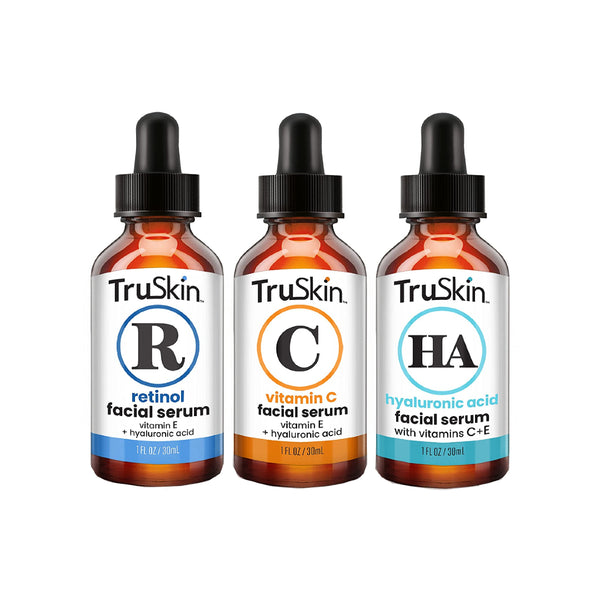 4. Niacinamide
4. Niacinamide
Great For: All skin types, particularly sensitive.
Otherwise known as vitamin B3, niacinamide is a gentle, but effective antioxidant. It works really well with the natural substances in your skin to improve tone, texture and the visible signs of aging.5. Salicylic Acid
Great For: Oily or combination skin.
Salicylic acid is an oil-soluble chemical exfoliator that gets deep into your pores to reduce excess sebum, reduce acne breakouts and boost cell turnover.How & When Should I Apply My Face Serum?
The general rule with skincare is that lighter products should always be applied first so they don’t have to fight with the heavies to reach the surface of your skin. This means, therefore, that serum should always be applied before moisturizer, to cleansed, toned skin. Then you can follow with a face oil and finally, that all-important, never-to-be-forgotten sunscreen (in the morning, of course!).
When it comes to your application technique, NEVER place the serum dropper directly onto your face as this can transfer oil and bacteria from your skin straight back into the bottle. Instead, apply one or two drops of serum onto clean hands, then apply it over your face and neck. Pat it gently all over cleansed skin and don’t worry about massaging it in. This is totally unnecessary. Serums are light enough to absorb into your skin without your help.
All serums are different, but most can be applied every day. Oftentimes, however, two or three times a week is enough – especially with the super potent serums that really pack a potent punch. Just make sure you read your labels for full instructions so you don’t overload your skin and end up causing irritation.
Up Your Fall Skincare Game With An Awesome New Face Serum
read more



